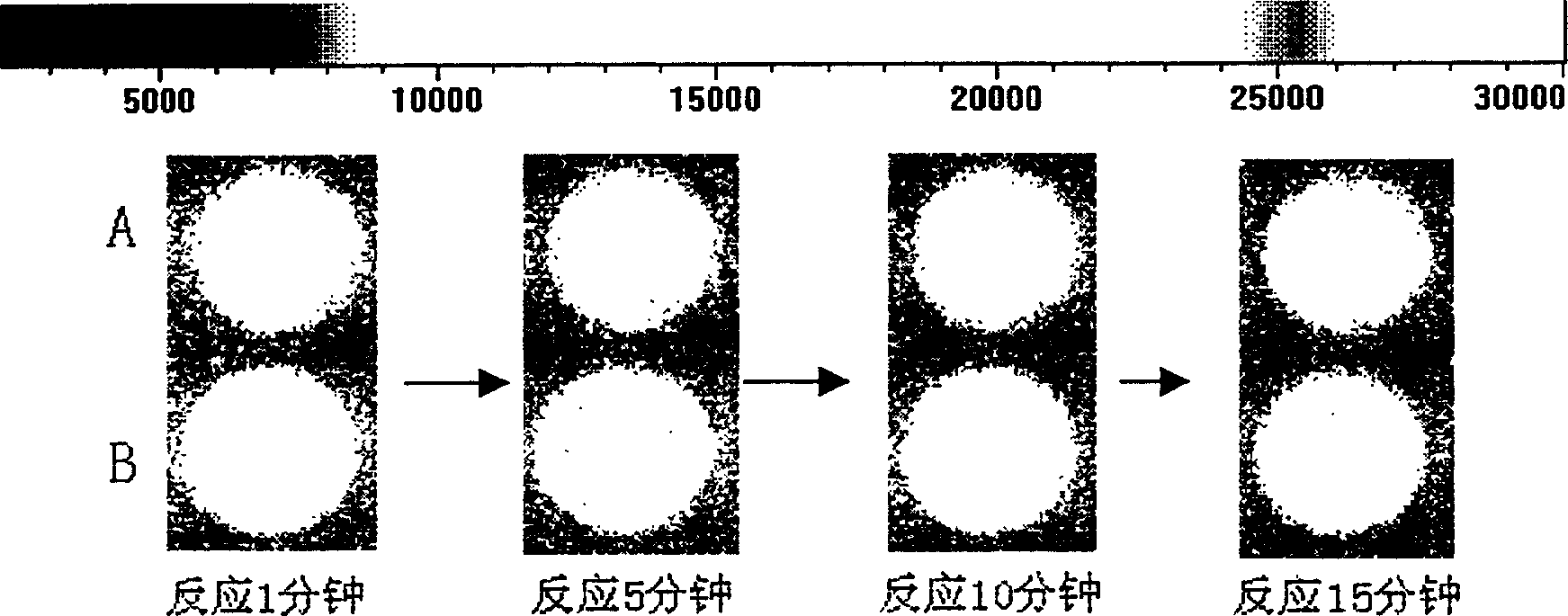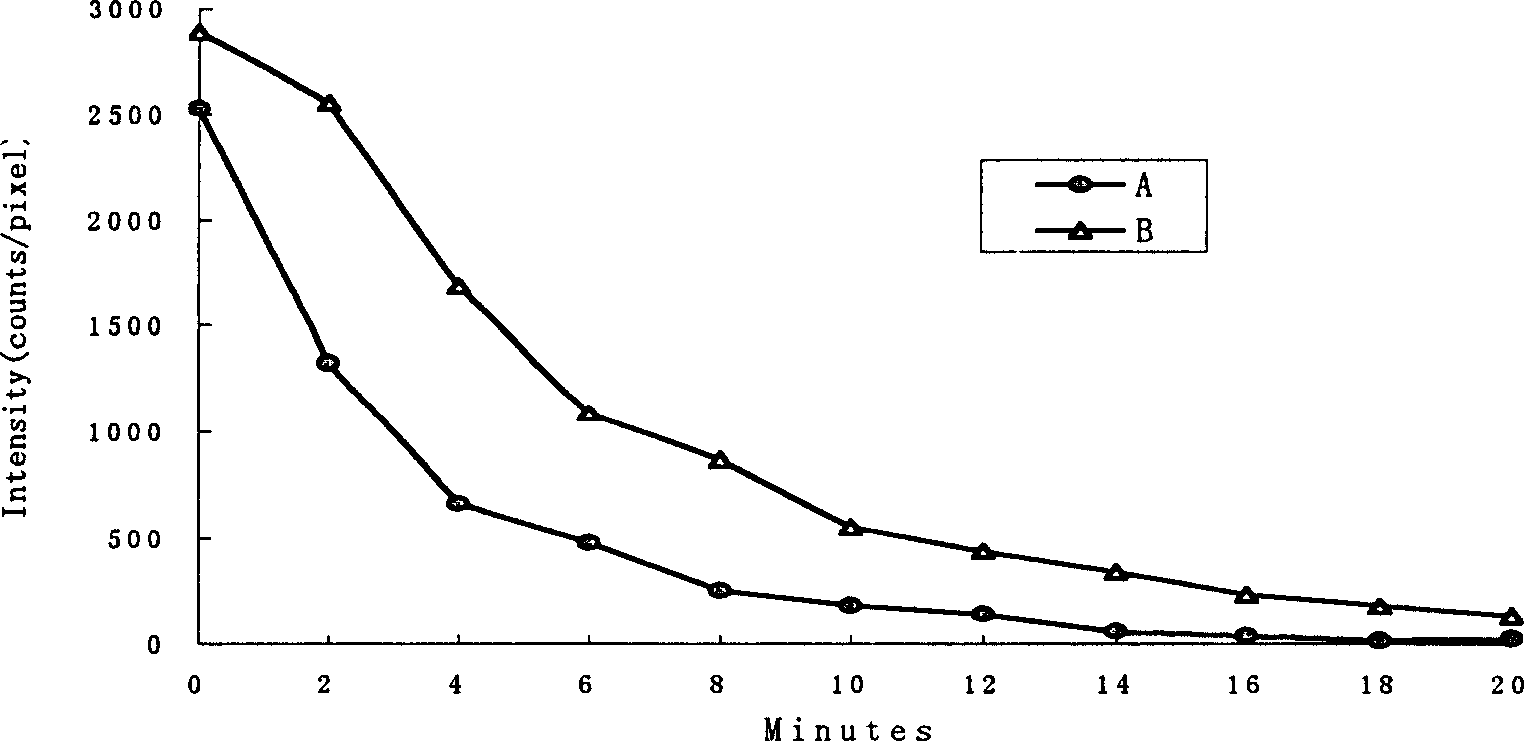Preparation method for nano chemical light emitting probe capable of natural degrading in living body
A technology of chemiluminescence and chemiluminescence reagents, which is applied in the field of preparation of nanoscale chemiluminescence probes, can solve the problems of unobservable reaction phenomena and difficult real-time detection, etc., and achieves simple production methods, improved detection sensitivity, and obvious experimental results Effect
- Summary
- Abstract
- Description
- Claims
- Application Information
AI Technical Summary
Problems solved by technology
Method used
Image
Examples
Embodiment 1
[0024] (1) Human serum albumin 10mg, chemiluminescence probe MCLA concentration 20umol / L, rapeseed oil 4ml, triple distilled water 2ml, nonionic surfactant Tween 80 concentration 1%.
[0025] (2) Under the condition of avoiding light, mix the human serum albumin solution with the chemiluminescence reagent MCLA solution diluted to the working concentration, then add rapeseed oil to it, and treat it with 150W ultrasonic wave for 1min at 0°C ; After adding the non-ionic surfactant Tween 80 with a concentration of 1%, continue to use ultrasonic treatment for 2 minutes, the mixture presents a uniform milky white.
[0026] (3) Divide the prepared emulsion, and centrifuge at 2000g / min for 10min at 4°C. After centrifugation, the oil from the emulsion was gently removed. This step is repeated several times until the oil separated out by centrifugation is basically removed.
[0027] (4) Heat and solidify the white emulsion obtained after centrifugation in an environment of 80° C. for ...
Embodiment 2
[0029] Human serum albumin 5mg, chemiluminescent probe MCLA concentration 10umol / L, rapeseed oil 2ml, triple distilled water 1ml, mix evenly; under the condition of 0℃, 80W ultrasonic treatment for 2min, add 0.2% non-ionic After surfactant Tween 80, continue to use ultrasonic treatment for 3 minutes. The prepared emulsion was subpackaged, centrifuged, and excess oil was absorbed, heated and solidified at 50° C. for 20 minutes, and then stored in a refrigerator at 4° C. in the dark.
Embodiment 3
[0031] Bovine serum albumin 50mg, chemiluminescence probe MCLA concentration 20umol / L, rapeseed oil 4ml, three-distilled water 2ml, mix evenly; under the condition of 0℃, 220W ultrasonic treatment for 1min, add 0.2% non-ionic After surfactant Tween 80, continue to use ultrasonic treatment for 1min. The prepared emulsion was divided into packages, centrifuged, excess oil was sucked off, heated and solidified at 80° C. for 10 min, and then stored in a refrigerator at 4° C. in the dark.
[0032] Wherein, the raw material that embodiment 1 adopts, consumption and condition are best among 3 examples.
[0033] as the picture shows, figure 1 It is a photo taken when the nanoscale chemiluminescent probe made according to the method proposed in the present invention was observed with a Japanese H-300 transmission electron microscope. For the results corresponding to Example 1, the particle size is 50-150 nm. Magnification 50k.
[0034] figure 2 In the in vitro experiment, the det...
PUM
| Property | Measurement | Unit |
|---|---|---|
| particle diameter | aaaaa | aaaaa |
| particle diameter | aaaaa | aaaaa |
Abstract
Description
Claims
Application Information
 Login to View More
Login to View More - R&D
- Intellectual Property
- Life Sciences
- Materials
- Tech Scout
- Unparalleled Data Quality
- Higher Quality Content
- 60% Fewer Hallucinations
Browse by: Latest US Patents, China's latest patents, Technical Efficacy Thesaurus, Application Domain, Technology Topic, Popular Technical Reports.
© 2025 PatSnap. All rights reserved.Legal|Privacy policy|Modern Slavery Act Transparency Statement|Sitemap|About US| Contact US: help@patsnap.com



